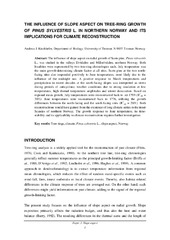Dendroclimatology on Scots pine (Pinus sylvestris L.) in northern Norway
Permanent link
https://hdl.handle.net/10037/2412View/
Andreas J. Kirchhefer: 'The influence of slope aspect on tree-ring growth of Pinus sylvestris L. in northern Norway and its implications for climate reconstruction', submitted version. Published version: Dendrochronologia 18 (2000), pp 27-40 (Elsevier). Check availability (PDF)
Andreas J. Kirchhefer: 'Pine growth and climate AD 1800-1992 along a transect across the Scandes at 69°N' (manuscript) (PDF)
Andreas J. Kirchhefer: 'Reconstruction of summer temperature from tree rings of Scots pine, Pinus sylvestris L., in coastal northern Norway', accepted version. Published version: The Holocene 11 (2001) pp 41-52. (Sage), available at http://dx.doi.org/10.1191/095968301670181592 (PDF)
Thesis introduction (PDF)
The thesis in one comprehensive pdf file (PDF)
Date
2000-03-17Type
Doctoral thesisDoktorgradsavhandling
Author
Kirchhefer, Andreas JoachimAbstract
A total of ten tree-ring chronologies of Scots pine, Pinus sylvestris L., was constructed between the Vesterålen archipelago and the Finnmarksvidda in order to investigate the regional variability of radial growth and climate response of pine. The longest tree-ring chronology, located in Forfjorddalen in Vesterålen, was highly significant back to AD 1354. The study area was divided into three dendroecological zones; the coast, the inner Scandes and the Finnmarksvidda. In all regions, July temperature was the most important growth-determining factor. At the coast, pine showed a significant positive response also to August temperatures. A partial study in the inner Scandes showed that the radial growth at north-facing slopes was enhanced by high June temperatures, most likely due to the influence of the midnight sun. Evidence of environmental stress due to
global warming was seen in reduced growth during periods of warm-moist mid winters
at the coast and, particularly in the warm 1930s, in the Scandes. Also, there were
indications of drought stress in summer in the intra-alpine valleys of the Scandes and at the edaphically dry coastal site, Stonglandseidet.
On the basis of the tree-ring chronologies, July temperatures were reconstructed back to AD 1800 for northern Norway 69°N and July-August temperatures along the coast back to AD 1358. The 20th century since 1915 was a period of above-average temperatures and growth. In the present reconstruction, a comparable warm period occurred previously only AD 1470-1540. In the 19th century, cool summers prevailed about AD 1810, in the 1830s and from the late 1860s to 1910. The 17th century, the coolest interval of the ‘Little Ice Age’, experienced three intervals of cool summers around AD 1605, 1640 and 1680. There was evidence of a lack of pine regeneration in the first half of the 17th century. Major regional temperature differences were observed around AD 1760 with extraordinarily warm summers east of the Scandes, but average temperatures at the coast, and about AD 1800, when the coast was warm, but the inland cooling. An exploratory reconstruction of June temperatures from growth differences between northand south-facing slopes demonstrated the potential of site-related growth responses for refined climate reconstructions.
On the basis of the tree-ring chronologies, July temperatures were reconstructed back to AD 1800 for northern Norway 69°N and July-August temperatures along the coast back to AD 1358. The 20th century since 1915 was a period of above-average temperatures and growth. In the present reconstruction, a comparable warm period occurred previously only AD 1470-1540. In the 19th century, cool summers prevailed about AD 1810, in the 1830s and from the late 1860s to 1910. The 17th century, the coolest interval of the ‘Little Ice Age’, experienced three intervals of cool summers around AD 1605, 1640 and 1680. There was evidence of a lack of pine regeneration in the first half of the 17th century. Major regional temperature differences were observed around AD 1760 with extraordinarily warm summers east of the Scandes, but average temperatures at the coast, and about AD 1800, when the coast was warm, but the inland cooling. An exploratory reconstruction of June temperatures from growth differences between northand south-facing slopes demonstrated the potential of site-related growth responses for refined climate reconstructions.
Publisher
Universitetet i TromsøUniversity of Tromsø
Metadata
Show full item recordCollections
Copyright 2000 The Author(s)
The following license file are associated with this item:
Related items
Showing items related by title, author, creator and subject.
-
Geometric Modeling- and Sensor Technology Applications for Engineering Problems
Pedersen, Aleksander (Doctoral thesis; Doktorgradsavhandling, 2020-10-20)In applications for technical problems, Geometric modeling and sensor technology are key in both scientific and industrial development. Simulations and visualization techniques are the next step after defining geometry models and data types. This thesis attempts to combine different aspects of geometric modeling and sensor technology as well as to facilitate simulation and visualization. It includes ... -
Iceberg Drift-Trajectory Modelling and Probability Distributions of the Predictions
Baadshaug, Ole (Master thesis; Mastergradsoppgave, 2018-06-29)Moving icebergs represent a major problem for shipping, as well as for oil and gas installations in ice infested waters. To be able to take actions against hazardous icebergs, it is necessary to develop models for prediction of iceberg drift trajectories. Many models have been developed in order to do so, using different approaches. These approaches can be divided into two main categories, dynamic ... -
Engineering methods for enhancing railway geometry and winter road assessment: A safety and maintenance perspective
Brustad, Tanita Fossli (Doctoral thesis; Doktorgradsavhandling, 2020-06-22)In many areas around the world there are limited transportation possibilities when travelling between key cities. If these areas also experience demanding weather conditions or geography, getting from A to B, during difficult conditions, is usually not optimal in regards to accessibility, safety, and comfort. Under challenging conditions, two essential elements in strengthening accessibility, safety, ...


 English
English norsk
norsk


